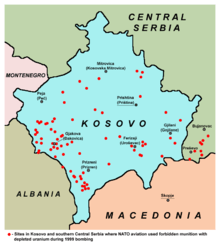Environmental issues in Serbia
1999 NATO bombing of Yugoslavia

The NATO bombings of 1999 caused lasting damage to the environment of Serbia, with several thousand tons of toxic chemicals stored in targeted factories being released into the soil, atmosphere and water basins affecting humans and the local wildlife.[1]
In 2001, doctors at the Serb-run hospital in Kosovska Mitrovica say the number of patients suffering from malignant diseases has increased by 200% since 1998.[2] In the same year, the World Health Organization reported that data from Kosovo was inconclusive and called for further studies.[3]
A 2003 study by the United Nations Environment Programme (UNEP) in Bosnia and Herzegovina stated that low levels of contaminate were found in drinking water and air particulate at DU penetrator impact points. The levels were stated as not a cause for alarm. Yet, Pekka Haavisto, chairman of the UNEP DU projects stated, "The findings of this study stress again the importance of appropriate clean-up and civil protection measures in a post-conflict situation."[4]
References
- 58-3 Archived 2011-05-11 at the Wayback Machine: "From the Pancevo industrial complex (petrochemical plant, fertilizer plant and oil refinery), which stands at the confluence of the Tamis River and the Danube, more than 100 tons of mercury, 2,100 metric tons of 1.2-dichlorethane, 1,500 tons of vinyl chloride (3,000 times higher than permitted levels), 15,000 tons of ammonia, 800 tons of hydrochloric acid, 250 tons of liquid chlorine, vast quantities of dioxin (a component of Agent Orange and other defoliants), and significant quantities of sulphur dioxide and nitrates were released into the atmosphere, soil and waterways. From the Zastava car factory in Kragujevac, unknown quantities of pyralene oil leaked into the Lepenica River (a tributary of the Velika Morava) via the sewage system."
- "BBC News | EUROPE | Uranium tests for Serbs". News.bbc.co.uk. 15 January 2001. Retrieved 2008-09-08.
- Report of the WHO's Depleted Uranium Mission to Kosovo (pdf 123kb) January 22–31, 2001
- Low-level DU contamination found in Bosnia and Herzegovina, UNEP calls for precaution United Nations Environment Programme, 25 March 2003. Retrieved January 25, 2009.